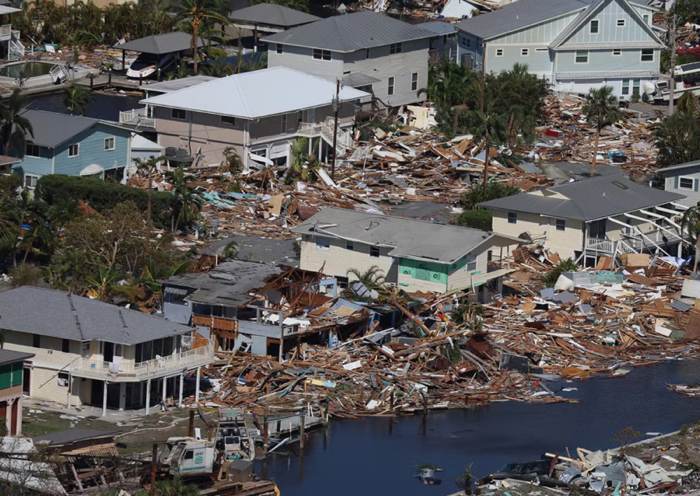Alternative capital’s resilience will be tested (again) by hurricane Ian: S&P

Alternative capital investors are about to have their resilience tested again, according to S&P Global Ratings, who said that although it is too early to have an accurate quantification of industry losses from hurricane Ian, it’s clear this is a major event for the reinsurance and ILS sector.
With each day more information emerges showing just how major an event hurricane Ian has been for global reinsurance and insurance-linked securities (ILS) markets.
Losses from hurricane Ian will not just be significant, perhaps historic for reinsurance and ILS market interests.
They will also be a significant test for ILS investors, especially in some collateralized reinsurance products and funds, coming on the heels of other loss years.
The losses will also significantly test ILS managers as well (some far more than others though, dependent on strategies and structures used), with the additional trapped ILS capital coming on top of capital still held after previous loss years, the ultimate effect of which is a prolonging of the additional burden of accounting and managing this side-pocketed capital, but also in fund-raising efforts for go-forward operations.
We highlighted a test that was coming back prior to hurricane Ian’s landfall. Now that we see the scale of the devastation and impending claims/losses, the test is even clearer and it goes far beyond testing how disciplined writers have been prior to Ian.
S&P is expecting a significant hit for global reinsurance companies.
“We believe global reinsurers will be significantly exposed to the damage caused by Hurricane Ian, but for this type of event, the question is whether the potential losses will remain within reinsurers’ catastrophe budgets or annual earnings or whether they will create a capital event,” the rating agency said.
Hurricane Ian raises issues around availability of retrocession, also how much retro was bought this year anyway.
Some of the largest reinsurers have far less retro in place for hurricane Ian, than they would have had for a hurricane loss in the prior year, as they have bought less in the harder market environment, and their third-party capital structures such as sidecars are often much smaller than before.
As a result, we believe there could be some surprises to come, to the downside, for reinsurer losses.
At the same time, we believe there could be some upside for some, especially where their use of third-party capital has been increasing and they are likely to share a significant proportion of losses with investors in those private often quota share based structures.
2022 is now well on-track to be a year with insured catastrophe losses well-above $100 billion.
The first-half estimates from reinsurers and brokers averaged around the $36.5 billion mark, and with hurricane Ian anticipated to add as much as $50 billion or $60 billion (perhaps more) in privately re/insured market losses, possibly much higher, $100 billion is well in sight given some of the other cat events seen, plus the loss creep from events earlier this year.
S&P expects that because of Florida market dynamics, where reinsurance tends to be more utilised by carriers, the share of hurricane Ian’s losses that flow to reinsurers and ILS funds or structures will be higher than for a typical catastrophe event.
“Florida is considered a peak zone for property catastrophe risk, and reinsurers have used alternative capital to manage their exposure. Therefore, we believe alternative capital will assume some of these losses, which will test its resilience again,” S&P explained.
The top 21 global reinsurers have had an average market share of global insured catastrophe losses of about 20%, S&P explained, but in the case of hurricane Ian this could be higher.
At around a $40 billion industry loss, S&P said the loss could fall within reinsurer cat budgets still.
But now estimates are heading higher, there is a chance this could become more of a capital event, than purely earnings, for some reinsurance carriers, it seems.
The higher the ultimate industry loss goes, the more will fall to reinsurers, typically. Although, in Florida, some carriers have been constrained in their reinsurance buying, meaning they may blow through their full limits available pretty quickly, effectively capping the reinsurance and ILS market’s exposure to their programs.
S&P estimates that for reinsurers, “combined earnings ($22.5 billion) and catastrophe budget ($15.5 billion) create a buffer of $38 billion before catastrophe losses would hit the sector’s capital.”
It now seems highly likely hurricane Ian’s loss will go well-above that level, so some impact to reinsurer capital should be anticipated now, it seems to us.
Either way, reinsurers catastrophe budgets are now set to be fully utilised by year-end, S&P said.
Adding, “The global reinsurance industry has a poor track record when it comes to earning its cost of capital (defined as the weighted average cost of capital). Reinsurers have failed to surpass this hurdle in the past five years (2017-2021) except 2019, and 2022 looks set to continue this trend. As a result, our view of the global reinsurance sector remains negative.”
Hurricane Ian may be the biggest test yet for alternative or ILS capital, but whether it is this single event that that test reflects, or the fact it comes after multiple others from recent years remains to be seen.
Read all of our coverage of hurricane Ian, and our analysis on the potential market losses, here.



